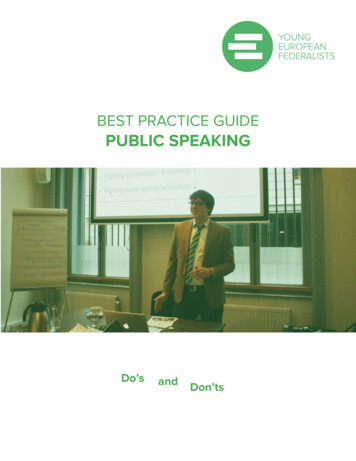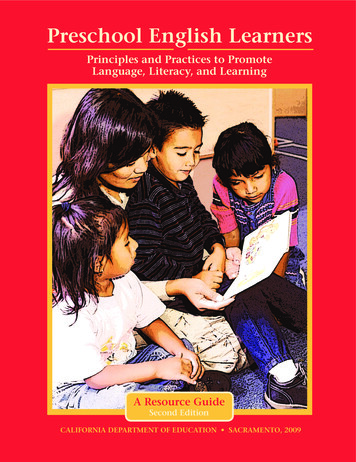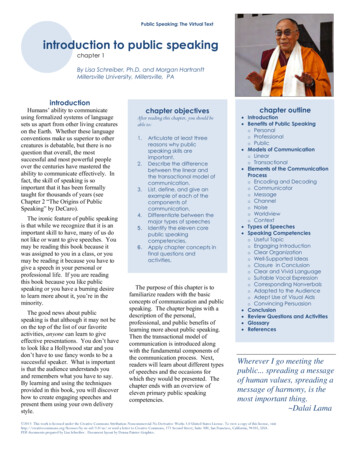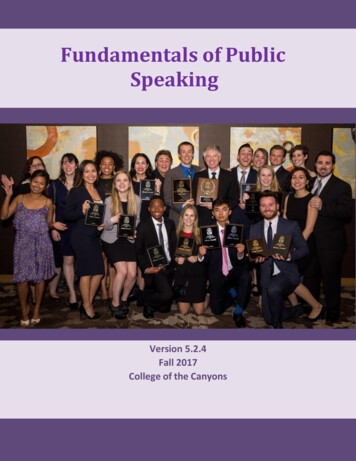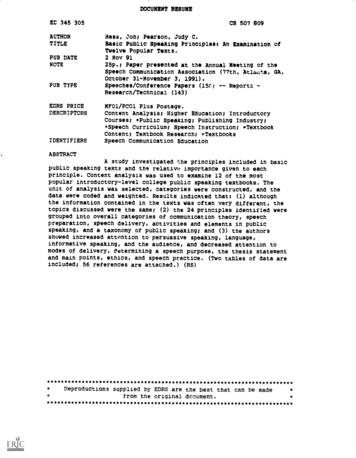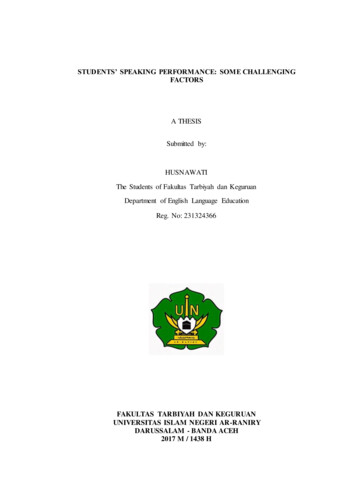
Transcription
Public SpeakingPublic Speakingtexas4-h.tamu.eduThe members of Texas A&M AgriLife will provide equal opportunities in programs and activities, education, and employment to all personsregardless of race, color, sex, religion, national origin, age, disability, genetic information, veteran status, sexual orientation or gender identityand will strive to achieve full and equal employment opportunity throughout Texas A&M AgriLife.
DescriptionThe Texas 4-H Exploreseries allows 4-H volunteers,educators, members, andyouth who may be interestedin learning more about 4-Hto try some fun and handson learning experiences in aparticular project or activityarea. Each guide featuresinformation about importantaspects of the 4-H program,and its goal of teaching youngpeople life skills through handson experiences. Additionally,each guide contains at least sixlearning experiences, which canbe used as a project guide, oras activities for six different 4-Hmeetings.PurposeTexas 4-H is designed to develop the youth of our state into productiveadult citizens. The 4-H Program uses a non-formal educational process ofengaging youth in a “learning by doing” process. This includes handson opportunities, participation in workshops and clinics conducted byvolunteer leaders or professionals, as well as competitive experienceswhich allow 4-H members to demonstrate the knowledge they havegained. Through this entire process, the youth are learning key life skillssuch as working with others, teamwork, cooperation, and goal setting.Through all experiences, youth get to interact with adult volunteers andcounty Extension agents.What is 4-H?4-H members across the nation are responding to challenges every day intheir communities and their world.As the youth development program of the Cooperative Extension Systemof land-grant universities, 4-H is the nation’s largest youth developmentorganization, empowering six million young people throughout the UnitedStates. Cooperative Extension of 1862 and 1890 land-grant universitiesprovide leadership to engage young people in 4-H in all 3,007 counties ofthe United States. The impact of the Cooperative Extension partnershipis profound, bringing together National Institute of Food and Agricultureof USDA, land grant universities and county government to resourcelearning opportunities for youth.Through America’s 110 land-grant universities and its CooperativeExtension System, 4-H reaches every corner of our nation—from urbanneighborhoods to suburban schoolyards to rural farming communities.Texas 4-H Youth Development texas4-h.tamu.eduWith a network of more than 6 million youth, 600,000 volunteers, 3,500professionals, and more than 25 million alumni, 4-H helps shape youthto move our country and the world forward in ways that no other youthorganization can.Texas 4-HTexas 4-H is like a club for kids and teens ages 5-18, and it’s BIG! It’sthe largest youth development program in Texas with more than 550,000youth involved each year. No matter where you live or what you like to do,Texas 4-H has something that lets you be a better you!You may think 4-H is only for your friends with animals, but it’s so muchmore! You can do activities like shooting sports, food science, healthyliving, robotics, fashion, and photography.Look for 4-H clubs at your school, an after-school program, a communitycenter, or even on a military base or through the reserves for militaryfamilies.Texas 4-H is part of the Texas A&M AgriLife Extension Service andthe Texas A&M System. Founded in 1908, 4-H is the largest youthdevelopment program in Texas, reaching more than 550,000 youth eachyear.The 4-H Motto and Pledge“To Make the Best Better!”I pledge: My HEAD to clearer thinking, My HEART to greater loyalty, MyHANDS to larger service and My HEALTH to better living, For my Club, myCommunity, my Country, and my world.Participating in 4-H4-H is a great program because it provides options for young people toparticipate. From a 4-H club located in your community, a SPIN club thatfocuses on one particular project area, or participating in 4-H throughyour classroom at school, 4-H allows youth to learn in many differentenvironments. If you are interested in joining 4-H, contact your CountyExtension Office and ask for a list of the 4-H clubs in your area. If you area school teacher/educator and would like to use 4-H curriculum or theseproject guides in your classroom, contact your Extension Office as well forassistance.
4-H “Learning by Doing” Learning ApproachThe Do, Reflect, Apply learning approach allows youth to experience the learning process with minimal guidance fromadults. This allows for discovery by youth that may not take place with exact instructions.EXPLORE THE CONTENTIntroduction of the topic, overview and explorationof content, and review of objectivesBuild on knowledgeby learning more andadvancing to the anothertopic/levelYouth use the skills learnedin other parts of their lives.Youth connect the discussion tothe larger world.Texas 4-H Youth Development texas4-h.tamu.eduYouth do with limited“how to” instructions.Youth describe resultsof the experience andtheir reaction.Youth relate the experienceto the learning objectives(life skills and/or subjectmatter).
4-H PUBLIC SPEAKING PROJECTLessonsLesson 1Dealing with Fear and Anxiety . . . . . . . . . . . . . . . . . . . . . 2Lesson 2Developing Your Own Style . . . . . . . . . . . . . . . . . . . . 7Lesson 3Getting to Know Your Audience . . . . . . . . . . . . . . . . . . . 15Lesson 4Writing Your Speech . . . . . . . . . . . . . . . . . . . . . . . . . . . . 20Lesson 5Practice , Practice, Practice . . . . . . . . . . . . . . . . . . . . . . 36Lesson 6Research Your Topic . . . . . . . . . . . . . . . . . . . . . . . . . . . . . 43Developed by:Mr. Luis SaldanaDr. Laura HuebingerMrs. Jana BarrettTexas 4-H Youth Development texas4-h.tamu.edu
4-H PUBLIC SPEAKING PROJECTLessonsDealing with Fear and AnxietyEXPLORE THE CONTENT:A 2001 Gallup poll showed that public speaking is one of thethings that Americans fear the most. Many fear public speakingmore than dying! Fast Company suggests that it is not thatpeople are scared of the actual speaking – it is the fear of publichumiliation and being ostracized from the group. That is, manyindividuals fear they will be rejected by the audience and thenscared that they will become a social outcast and be shunnedfrom the social group. This fear is known as glossophobia.TIME:60-90 minutesMATERIALS NEEDED:Activity 1: Throw That Fear Away One piece of paper per participant Pen/pencil for each participant Large trash canActivity 2: Focus on the Auditory Short passages to read (participantscould bring them to the meeting orthe instructor could provide somesamples)Activity 3: Storytime NoneOBJECTIVES:The 4-H member will: The student will be able to understandthat fear of public speaking is not unusual. The student will be able to recognize thereasons for fear of public speaking. The student will be able to learn ways tohandle anxiety of public speaking. The student will be able to practicespeaking to reduce anxiety.However, rather than focusing on what the fear is, help yourstudents understand that is it normal and learn ways to minimizethe effects of glossophobia. Steven Cohen, speech instructor fromHarvard Extension School recommends that speakers focus on theopportunity to share their ideas rather than the uncertainty theymight experience. He suggests three categories of ways to handlethe fear of public speaking: visualization, relaxation techniques,and practice.Visualization includes thinking and seeing yourself be successful.Encourage participants to see themselves at a speaking eventand walking through each of the steps from entering the room towhen they finish the speech.You may encourage your participants to record themselves towatch and see themselves doing well. Relaxation techniquescan help a presenter beat their nervousness. The most commonsuggestion is a series of long, deep breaths. Exercising themorning of a big speech is another way to relieve some of thestress a speaker may feel about an upcoming presentation.See the Controlling Fear handout for additional methods ofcontrolling some common symptoms of being nervous. Andfinally, practice, practice, practice. Anxiety will lessen as a speakerhas more opportunities to practice. Speakers should spend extratime practicing their opening and conclusion. This practicedintroduction can significantly help the speaker get started with thespeech without the anxiety taking over. The strong conclusion canhelp the speaker and audience feel confidence as the speech ends.Storytelling and dialogs are helpful methods to assist withspeaking anxiety. The act of telling a story – especially personalstory or a very-well known story – will help the speaker to feelmore relaxed and sound more authentic when speaking. Askingquestions of the audience helps to create a dialog between thespeaker and the audience keeping the audience engaged andallowing the speaker time to breathe and pause. Both of thesemethods also encourage the speaker to focus on the ideas of theTexas 4-H Youth Development texas4-h.tamu.eduPage 2
public speaking PROJECTspeech rather than specific memorization of the words in a written speech. Focusing on the main ideas will help theconversation flow more easily.DO:Activity 1: Throw That Fear Away Ask youth to write down on a piece of paper their fears, hesitations, or what they think is scary about giving apublic speech or talking in front of a group. Allow a few to minutes to complete this. Make sure no one writestheir name on their paper. Once everyone has completed writing their fear on their piece of paper, ask the participants to wad their paperinto a snowball-sized ball and go stand in an open space. The participants may stand in a circle or simply bescattered randomly in the open space. Have the participants throw the snowballs at each other as if having a snowball fight. Continue to pick up thesnowballs nearby and continue throwing them for a few more minutes. When the facilitator calls to stop, everyone quits throwing and pick up one snowball that is closest to them. Ask each participant to introduce themselves and read the fears listed on the snowball they picked up. Ideally, noone should have their own fears to read.REFLECT: What common fears does our group have about public speaking?Do you think these are realistic fears?APPLY: What are some strategies to overcome these fears?After discussion has come to a close, put a large trash can in the middle of the room and have everyone throwaway the fears. Encourage the participants to understand that participation in the Public Speaking group andthrough practice, those fears can lessen, and they will build the confidence to become comfortable whenspeaking in public.DO:Activity 1: Focus on the Auditory The focus of this activity is the auditory presentation; not the physical presentation. Prior to the meeting, ask each participant to bring a written document that they are somewhat familiar with. Itcan be a short book, blog post, poem, monologue, or any short passage. The goal is for the passage is for it to beabout 1-4 minutes in length when read aloud.»» Another option would be for the adult leader to bring several samples of written documents and allow theparticipants to choose one. Ask each participant to take a turn reading their written document to the group. Ideally, since this activity isfocusing on auditory presentation, the speaker should not be at the front of the group where they are beingwatched by everyone. There are several options for this:»» All the participants would stay seated at their own chairs while the speaker reads from his or her own chair.»» The speaker could sit in a chair at the front of the room with his or her back to the rest of the group.»» The speaker could sit in a chair behind a curtain or sound-permeable divider, so the rest of the group can hear,but not see the speaker.»» The speaker could be speaking on microphone where he or she is out of the view of the rest of the group.Texas 4-H Youth Development texas4-h.tamu.eduPage 3
public speaking PROJECTREFLECT: What was the hardest part of reading your passage today?What was the easiest part of reading your passage today?What were some good examples of things we heard today?Generally speaking, what are some things that our group could do to continue to improve their speaking?APPLY: What are some ways that we can continue to improve with our speaking?How will speaking behind a curtain (or other auditory-only method) help us to get better at public speaking?DO:Activity 3: StorytimeOne of the easiest ways that a speaker can relax is by telling a story that they are familiar with. Ask each participant to think of a story that they could retell in about 3-5 minutes. This story could be aboutthemselves, about someone they know, something they read, or completely made up.»» A suggestion would be something that happened today at school or over the weekend with their family.»» Do not focus too much on the content. Ideally, this would be a story they could tell off-the-cuff and shouldnot require any written notes. Ask the participants to get into small groups (approximately 3-5 participants). Ask each participant to share theirstory with their small group. As the adult leader, observe the participants and take notes of voices, facial expressions, hand motions, etc. Youmay even select one or two participants to share their story with the large group.REFLECT: Was it easier or harder for you to talk when you were telling a story rather than focused on specific facts andmemorization of a speech?How did the speakers’ voices change throughout their stories? What about their facial expressions? Handmotions?APPLY: What can we learn from this activity that can help us to improve our speaking? (speaking is more than justreading of words involving voice inflection, facial expressions, etc.; storytelling may be a way to help ease fearswhen speaking, etc.)Review the “Tips on Controlling Fear with Public Speaking” handout. Ask participants if there are any additionalsuggestions on how to handle these symptoms or if there are additional symptoms – and their possible solutions– that may not be listed.Additional Activities to Extend the Content:There are many different activities, tip sheets, and articles on the Internet regarding public speaking. By far, the mosthelpful activity to help reduce fear and anxiety is practice in a trusting environment. Here are two places to lookfor more information: Public Speaking Power, -activities/ has a list of fifteen funactivities to try with your 4-H members. Glossophobia.com, http://www.glossophobia.com/index.html has videos from experts to help share tips andtricks related to public speaking.Texas 4-H Youth Development texas4-h.tamu.eduPage 4
public speaking PROJECTREFERENCES: Croston, G. (2012, November 29). The thing we fear more than death. Psychology Today. Retrieved from obia.com. (n.d.). http://www.glossophobia.com/Grayson Riegel, D. (2013, January 17). 3 strategies for managing public speaking anxiety. Fast Company. Retrievedfrom anaging-public-speaking-anxietyHarvard Extension School. (2013, February 27). How to overcome the fear of public speaking: 3 tips [Video file].Retrieved from https://www.youtube.com/watch?v 3fz0eiBGvAMenabney, D. (2018, January 18). Want to be a more confident speaker? Tell a story. Fast Company. Retrieved e-a-more-confident-speaker-tell-a-storyPublic Speaking Power. (2013). http://publicspeakingpower.com/Schwartzberg, J. (2017, December 11). Try this simple trick to beat your public speaking anxiety. Fast Company.Retrieved from le-trick-to-beat-you-public-speakinganxietyTexas A&M AgriLife Exetnsion Service. (1999). Public Speaking.4-H Style (COM 1-2.050). Retrieved from 09/publications public speaking 4h style.pdfUtah State University Extension. (2017). Discover 4-H: 4-H Public Speaking Clubs. Retrieved from https://usu.co1.qualtrics.com/CP/File.php?F F 1Gm9L54i34rcOhLSupport Materials/Graphics (please attach all support materials, handouts, high resolution graphics thatshould be included or attached at the end of lesson)Tips on Controlling Fear with Public SpeakingAdapted from: Public Speaking 4-H Style (1999)Many individuals experience nervousness or anticipation prior to a speech. These feelings can range from beingslightly “keyed up” to complete physical panic. What we refer to as “fear” comes from the strong desire to do ourbest in front of others. The only speaker or performers who do not experience some sensations are those who do notcare how they do. The following chart will help you identify and relieve your specific symptoms.Remember, even if you drop all your notes, ruin your notecards with iced tea, fall on the way to the lectern, break offyour heel on the platform, or blow out the bulb on the projector, do not apologize – cope! Life is full of unexpectedevents. The way you handle the unexpected is what is important. You owe the audience the courtesy of not makingthem suffer for your discomfort. So, speak without notes or shoes or projects. Get your main points across in asimple, clear manner and do no worry that it was not the way your planned – not much in life it!Relax! Here are some ideas to try: Brisk exercise such as walking or jogging can reduce tension. Yawning is relaxing. Deep breathing. With mouth closed, inhale through your nose as deeply as possible. Hold this breath to the countof five (1-2-3-4-5) and then release it to the count of ten (1-2-3-4-5-6-7-8-9-10). Repeat several times. Become a rag doll and shake out your body. Stop and exhale or pause and swallow. Allow your hands to unclench and your armpits to breathe. Changepositions at the lectern. Avoid anything to drink stronger than water because it can bring on various side effects such as burping, nauseaor worse. Especially avoid caffeine drinks, alcohol or pills or drugs that stimulate or relax. Any of these productscan produce an adverse effect at the wrong time. Build confidence. Strive for success. Set yourself up for a successful speech with adequate preparation and a sincere desire to shareyour knowledge or experiences with your audience. The feeling of success will be well worth any anxieties youhave experienced.Texas 4-H Youth Development texas4-h.tamu.eduPage 5
public speaking PROJECTSymptomsSolutionsNervous stomach (butterflies)Slow, controlled breathing. Avoid eating prior to speaking.Vomiting, nausea, diarrheaAvoid eating ahead of time.Consult your doctor or pharmacist for over-the-counterpreparations.Jelly legsMove around. Shaking rarely shows to the audience so try notworry about it.Trembling hands and a rattling manuscriptUse 3x5 cards. Connect them by rings and flip up each one as youuse it. Or invest in a small notebook in which to place the cards.Stumbling over words, getting “tonguetwisted” or major bloopersBreathe deeply and slow down your speaking. Repeat a sentenceif necessary. Do not apologize.Shortness of breathSwallow, breathe and exhale. Make eye contact with a friendlyface and continue.Shaking voiceMake strong eye contact with a friendly face. Swallow and loweryour pitch. Slightly increase your volume.BlushingFrom a distance and under the lights, this usually looks like ahealthy glow so try to forget about it and continue.Red blotches on neckAvoid low-necked clothing.Cold hands and feetMove around; make some hand gestures.Hoarseness prior to speakingRemain silent for 24 hours before speaking. Do not even whisper.Drink lots of warm drinks. If the problem is still present when youbegin to speak, move in close to the microphone.Going blankLook at your notes. Consider this pause a “thoughtful silence.”Excessive perspiration (arms)Light colors show circles less. Dress shields (purchased at a fabricshop) pinned under the arms can be helpful. Try an antiperspirant.Excessive perspiration (hand and forehead)Take a cotton handkerchief to absorb moisture on your palms.Wipe your brow with no apology, if you absolutely must.Dry mouthAvoid drying agents such as antihistamines and decongestants.Even salt water tends to dry. Use lip balm on your lips and eventeeth. Keep a lemon drop, small peppermint candy, or cinnamoncandy under your tongue to produce saliva.A cold or coughTake tissues and even a cough drop to the lectern. Do notapologize to your audience. The cold seems worse to you than tothem.Texas 4-H Youth Development texas4-h.tamu.eduPage 6
LessonsDeveloping Your Own Style: Verbal andNon-Verbal Strategies4-H PUBLIC SPEAKING PROJECTEXPLORE THE CONTENT:While the content of a speech is extremely important, verbal andnon-verbal actions of the speaker can certainly influence how theaudience interprets the content and reacts to the speech. Thislesson will explore verbal and non-verbal actions such as bodylanguage and voice to help beginning speakers identify actionsthat will positively influence their speaking, as well as behaviors toavoid during a speech.DO:Activity 1: Body Language and VoicePark BenchThis game will focus on body language and what we see and learnfrom it.TIME:60-90 minutesMATERIALS NEEDED:Activity 1: Body Language and Voice Printed character cards, cut individually Bench (or two chairs seated side-by-sideActivity 2: Public Speaking Do’s and Don’ts Printed Do’s and Don’ts Role Play Cards,cut individually Whiteboard or easel pad Marker for whiteboard or easel padActivity 3: You Be the Judge Computer with internet connection Links to YouTube videos Projector for computer Blank screen or wall for video projection Speakers to hear audio from video Blank paper (or public speaking scoringrubric) for each student Pencils/pens for each studentOBJECTIVES:The 4-H member will be able to: The student will be able to understand therole of body language in a speech. The student will be able to understand therole of verbal actions in a speech. The student will be able to identify goodand bad verbal and non-verbal actions of aspeaker. The student will be able to identify verbaland non-verbal skills to practice in order toimprove their speaking abilities.Each member chooses a “character” to play. There is a list ofCharacter Cards if needed for ideas. Feel free to include additionalcharacters on the play cards that may be more applicable to yourgroup or allow students to select their own character.Using body language, the first player sits silently, “on a parkbench,” displaying as much about their character as they canwithout using any verbal cues or words. The next player walks in,again, using body language and no verbal cues or words to act outtheir character.The two players interact for only about 10-30 seconds and thenthe first player finds a reason to leave. The second player is thenleft to sit on the park bench along until the third player comes in,again focusing on body language and not on verbal cues or words.This continues until all the members have had a chance to playonce or twice.What did the members notice about how people were acting?Sitting? Standing? Did you want to talk to certain people morethan others? Why? Talk to members about the importance of nonverbal cues.HelloNow let’s add the voice. Discuss the importance of diction, tone,and projection.Have members practice saying “hello” in the following styles: (Mayrepeat the word “hello” as many times as needed) ShylyTexas 4-H Youth Development texas4-h.tamu.eduPage 7
public speaking PROJECT Greeting someone you would rather not seeAnswering the phone when no one is thereLooking for someone you can’t findTelling someone that something he/she just said is sort of dumbBoominglyAnswering the telephoneTrying to get someone to open a doorFlirtinglyGreeting someone you haven’t seen for a long timeAdd other variations as neededREFLECT: Be aware of how your body position and movement is involved in communicating your verbal message to others.Is your body sending the same message as your words?Can you change your body to make your message clearer?When talking with someone, notice their body language. Are you able to understand their message more clearlyby watching their body movement?How does the pitch and volume of your voice affect the message you’re communicating?APPLY: How does body language used during a speech differ from body language used in daily interactions?How does body language affect your daily conversations?Does your body language appropriately demonstrate what you would like to share? Does it need to be adjusted tobetter demonstrate your emotions?How does your voice (pitch, tone, and volume) affect your daily conversations?DO:Activity 2: Role Playing: Do’s and Don’tsOn a whiteboard or easel pad, make two columns: One that says. “Do’s” and one that says, “Don’ts.” Ask eachmember or pair of members to draw out one of the Do’s or Don’ts Role Play Cards (attached). Ask the individuals orpairs to demonstrate or act out the correct and incorrect way of giving a speech, based upon what was written ontheir Role Play Cards. Have the other members guess what they are doing.As the members guess or give suggestions on what the members are acting out, write the action item on thewhiteboard or easel pad under the appropriate “Do’s” or “Don’ts” column. When discussing the actions, groupthem into categories such as body language (eye contact, posture, gestures, movements), words (um, er, like, pleaseconsider, studies show, etc.), what to wear, speaking voice (loud, soft, vocal patterns, etc.). Also highlight any othersuggestions that may arise.REFLECT: Discuss what Do’s and Don’ts were seen.Which actions are good and which actions are bad during public speaking?What are some ways we can implement the desirable (good) actions during a speech?What are some ways we can avoid the not so desirable (bad) actions during a speech?Texas 4-H Youth Development texas4-h.tamu.eduPage 8
public speaking PROJECTAPPLY: What are some actions you can work on individually to help improve your speeches (posture, saying um, rockingback and forth, talking too quietly, etc.)?We just identified ways that we can use good actions and avoid bad actions when speaking. Which actions areyou personally going to put into place to help you become a better public speaker?What can I, as your adult leader, help you with so you may continue to improve?Determine a simple topic for a 2-3-minute speech and encourage speakers to develop a short speech andimplement the skills discussed during this project meeting. This could also be a “homework” assignment and askspeakers to come back to the next meeting prepared to give their speech.DO:Activity 3: You Be the JudgeAs a group, watch a video (or two or three) of 4-H demonstrations on YouTube. Some examples are as follows:Squeak: https://youtu.be/s-dqHvfls0YThe Affordable Laundry Act: https://youtu.be/ggSqTYPAjp84-H Presentations: Presentation Using Audio Visual: https://www.youtube.com/watch?v qX0NX15KEJ0)As members view the videos, encourage them to take note of the speakers’ voice (projection, inflection, tone, volume,etc.), body language (posture, fidgeting, eye contact, hand motions, etc.), as well as other verbal and non-verbalactions such as poise, confidence, attire, and even visual aids. Members could take notes on their own blank paper oruse a scoring rubric for a 4-H speaking event.REFLECT: After each demonstration, ask the group to evaluate the presentations as if they were the judges. Somesuggested questions are as follows:What were some of the strengths?What were some weaknesses?Select an action seen in the video (for example, use of voice). Ask participants to describe the action asdemonstrated by each speaker, pointing out positive uses of this action and ways to improve for the future.APPLY: If it were you giving the presentation, what would you do differently?Distribute the handout, Preparing and Delivering Your Speech. Discuss how some of these actions can be put intopractice.REFERENCES: Texas A&M AgriLife Extension Service. (1999). Public Speaking.4-H Style (COM 1-2.050). Retrieved from 09/publications public speaking 4h style.pdfTexas A&M AgriLife Extension Service. (2010). 4-H Public Presentation Guide: Educational Presentations and Talks.(4-H 3-5.012). Retrieved from 09/publications publicspeaking presentation guide.pdf Michael Jackson R2D2Utah State University Extension. (2017). Discover 4-H: 4-H Public Speaking Clubs. Retrieved from https://usu.co1.qualtrics.com/CP/File.php?F F 1Gm9L54i34rcOhLVokac, Ruth Ann. (2003). Play the Role, National 4-H CurriculumSUPPORT MATERIALS/GRAPHICS:Texas 4-H Youth Development texas4-h.tamu.eduPage 9
Activity 1: Park Bench Character CardsMichael JacksonR2D2Mark ZuckerbergHarry PotterMomElsa from FrozenAriel from The Little MermaidSanta ClausWonder WomanWitchBatmanIron ManChefMickey MouseJustin BieberHumpty DumptyA zombieFirefighterGeorge WashingtonPolicemanSupermanMailmanThe Incredible HulkTeacherSpidermanTaxi Driver MomFrankensteinOld Man / WomanDarth VaderDad
Activity 2: Public Speaking Do’s and Don’ts Role Play CardsYou slouch in front of your audience.You sigh with boredom betweensentences.You start walking back to your seat beforeyou finish speaking.You tap your foot loudly while you arespeaking.You swallow frequently.You lose your composure while speaking.You giggle nervously at the end of eachsentence.
speaking to reduce anxiety. EXPLORE THE CONTENT: A 2001 Gallup poll showed that public speaking is one of the things that Americans fear the most. Many fear public speaking more than dying! Fast Company suggests that it is not that people are scared of the actual speaking – it is the fear of public
